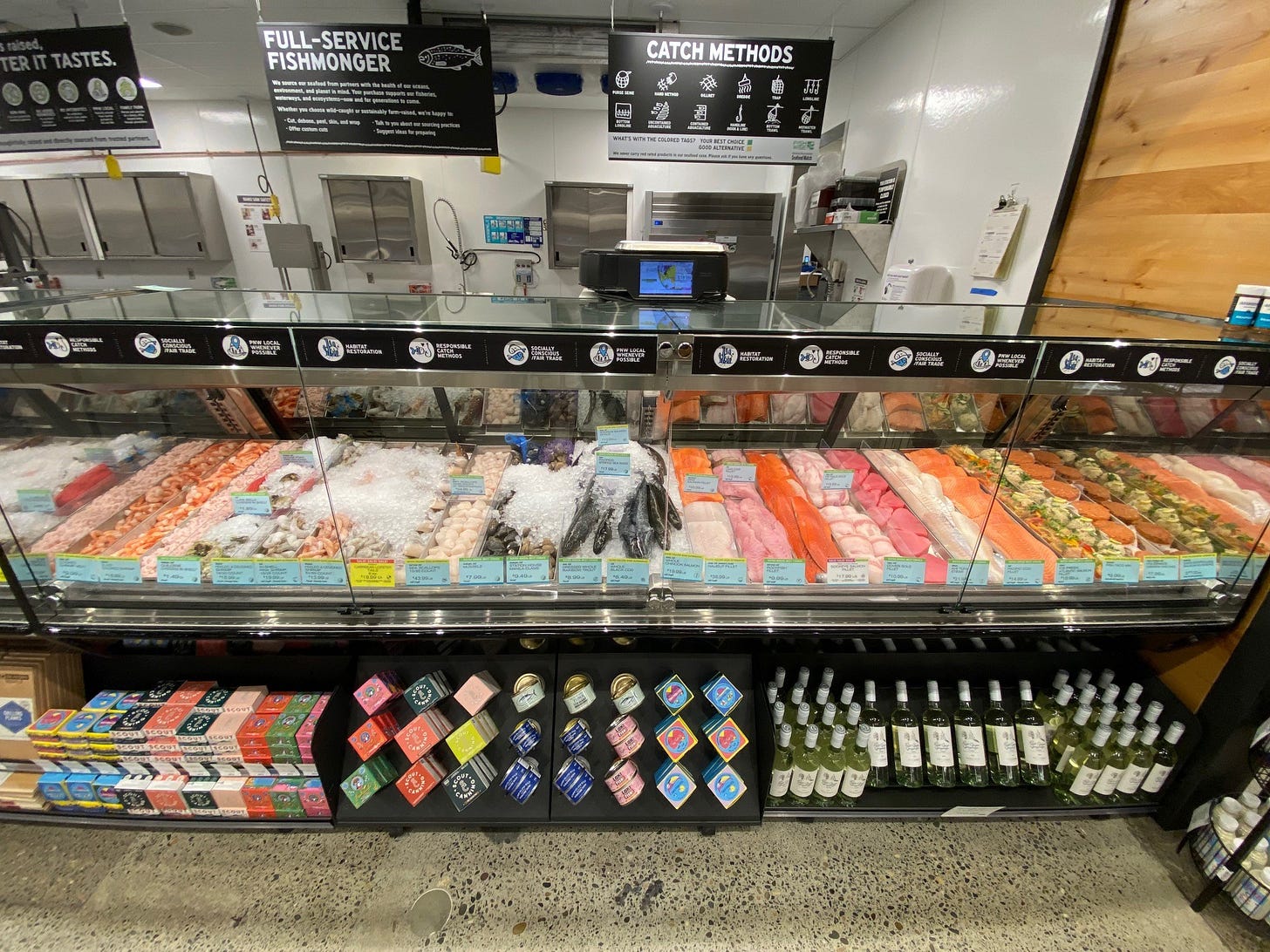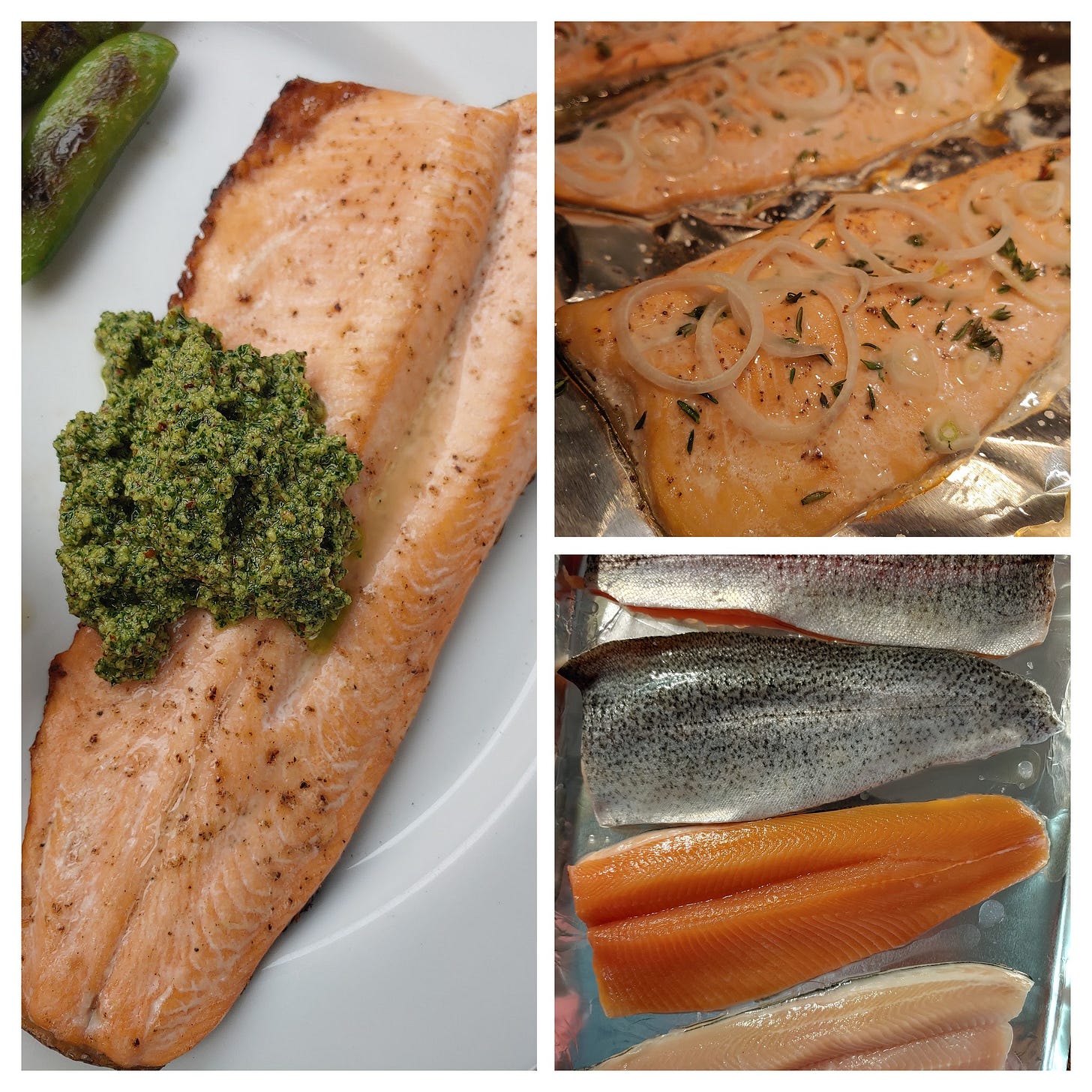This newsletter will frequently have a mix of new explorations and discoveries alongside mention of adventures, meals and other subjects from the past. The latter appeals to my deeply nostalgic nature and to the fact that a lot of bygone topics, trends and themes can feel quite interesting and current today. Some conversations around seafood seem to have a certain timelessness.
The retro glance below is one that goes back to my time at Simply Seafood magazine, in this case recalling when I wrote about Le Bernardin, that glorious New York City seafood restaurant. It’s nudged in part by having just read of the restaurant’s 50th anniversary this year. As an ideal example of how these occasional doses of seafood nostalgia can hold some element of current relevance, a theme mentioned in that article years ago reflects part of a conversation I had with a seafood retailer last week. It has to do with not being too fixated on the seafood you’re hoping to buy.
In the case of Le Bernardin, I wrote of a tip home cooks could take from the scrutiny with which chef Eric Ripert selected (and still does, I’m certain) the seafood served at the restaurant, that it was a good lesson “to adjust our menu plans to take advantage of the best seafood available at the market, rather than buying seafood that isn’t at its prime simply because it’s on the shopping list.”
Last week I had a chat with Daisy Berg, Seafood Program and Category Manager for New Seasons Markets in the Portland, Oregon, area. Part of our conversation included discussion of ways that customers can have better experiences when shopping for seafood. She encourages customers to keep an open mind when they walk up to the seafood counter, to not be too stuck on a particular type of seafood, pending what’s in the case that day. One recommendation she had was to ask the seafood staff what they might choose for their own dinner that night, as a hint about an item or two among the best selections. Shopping with a bit of flexibility can be a key to having consistently great experiences with seafood.

P.S. My favorite meal of the year is just around the corner. Being the nostalgic that I am, I generally weave a certain number of traditional elements into the Thanksgiving menu. There will be a turkey, rotisserie-cooked on my charcoal Weber (occasionally it’s duck instead, some years I grill a salmon fillet, too). Mashed potatoes, gravy, stuffing, old-school onion dip to snack on. There will definitely be seafood too, this year in the form of smoked salmon + fixings among appetizers, a course of sauteed scallops (still unsure the exact prep I’ll go with) and making a salmon pirog, inspired by reminiscence a couple of issues ago about my trip to Kodiak Island. For those among you celebrating Thanksgiving in a couple weeks, will seafood make an appearance on your Thanksgiving table? Is there a seafood dish that’s been part of Thanksgiving tradition for you and your family and friends? Let me know in the comments below. Despite this newsletter being a few days late, the next should show up the day before Thanksgiving, in the midst of the delight of that frenzied cooking prep. It would be fun to share some of what you’ve got in store for seafood at this holiday meal. And I may get a few ideas for my own menu next year!
On Location: Riverence
I’ve been deeply engrossed in the world of shellfish in recent years, not just as subject of my most recent book but the two prior as well, which focused on crab and oysters. While shellfish remains top of mind for now (the work of selling books continues!), I welcome delving back into the world of finfish more now too. Among the first steps was a chance to remind myself how fabulous trout can be.
I first heard about Riverence early this summer, watching Todd English, the Vice President of Sustainability with Riverence Provisions, discuss their trout and demonstrate a couple of preparations at the Smithsonian Folklife Festival in DC. I reached out to learn more about this company that raises trout in Idaho, where there is a legacy of farming trout in the state’s Snake River Canyon that dates back many decades. And they’re doing so with a commitment to preservation of the environment, carefully-sourced feed and addressing other issues of particular interest with aquaculture today. In fact, Riverence has been certified by the Aquaculture Stewardship Council in recognition of their commitment to ecologically sound and socially responsible practices.
It just so happened that a couple months after learning of Riverence I was going to be in Idaho. With a day off between teaching a couple of classes at the Sun Valley Culinary Institute, I took a drive south to the Snake River and had occasion to visit a couple of their farms. My first time in the area, I found the landscape to be particularly breathtaking.
Water used in the raceways—the structure of waterways that the trout inhabit on the land-based farms—comes direct from natural springs in the area. I’ve never seen springs like those I saw at Crystal Springs, gushing out the side of the canyon. The spring water comes out of the ground at a consistent 58 degrees, an ideal temperature for trout, so trout farms calling this area home is no accident. Seeing this striking environment and learning more about their aquaculture practices helps me appreciate the quality that can be found in farm-raised products like theirs.
Riverence kindly sent me some of their rainbow trout and steelhead trout fillets to play around with. It being summer at the time, many of the fillets went on the grill, setting them skin-side down over the hot coals to cook. I also cooked some in the oven, laying the fillets on a foil-lined sheet pan for baking. (Not oiled, so skin intentionally sticks to the foil; for serving, you slip the spatula just under the fillet to lift it off, leaving the skin behind.) Sometimes I added flavor accents before—minced garlic and ginger, or sliced sweet onion with fresh thyme—sometimes I seasoned with a touch of salt and finished with pesto or a tomato-herb topping just before serving. Wonderful flavor and so easy for a quick dinner.
Retro Seafood: Le Bernardin
I’d definitely planned to get to Le Bernardin at some point soon-ish in this content. Seeing this week that the venerable New York City restaurant is celebrating its 50th anniversary—it jumped up the list pretty quickly. This great article in the Wall Street Journal marking the occasion points out that 50 years ago the brother-sister team of Gilbert and Maguy Le Coze opened the original Le Bernardin in Paris. Their move to New York came in 1986.
I paid my first visit there while working on a 1995 article for Simply Seafood about some of the top seafood destinations in New York City at the time (others included Oceana, The SeaGrill, City Crab). In that piece with brief items about a number of restaurants, I mentioned of Le Bernardin that some had wondered how a fine dining restaurant serving only seafood would survive in New York. “Now, close to 10 years later, no one’s wondering any longer,” I wrote at the time. Twenty five-plus years after that, the question has long been forgotten.
I returned to Le Bernardin two years later to do a feature story about the restaurant. It was a joy to write, of course. One of the best things about that job was the opportunity to visit so many outstanding seafood destinations, to interview and learn from an array of amazing chefs. This was an absolute highlight. I only wish I’d heeded my own advice from the end of the article, that “every seafood enthusiast deserves to eat at Le Bernardin at least once in his or her life—but preferably as often as possible.” (italic emphasis added) It’s been a good decade or more since my last visit. I won’t let another trip to New York go by without returning, however. It will include an overdue toast to their 50th and a nod to the pleasure and delight that Le Bernardin has brought so many seafood-lovers over those years.
Odds and Ends: Crab Math
A random tidbit if you’re ever standing at the seafood counter looking at your Dungeness options, or otherwise contemplating whether you should buy Dungeness crab in the shell or as bulk meat when meat is what’s needed for your recipe. It was something I contemplated a lot while working on my crab cookbook. With all that crab at hand for testing, I checked my yields a number of times, comparing the weight of the whole crab with the weight of the meat I got out of it. Overall, the average was about 25% for my efforts. Of course, that will vary with the thoroughness of picking and the size of the crab—a larger crab will generally have a better meat-to-shell ratio than a smaller one.
At that ratio, from a purely dollars-and-cents perspective, the price per pound for the meat part of the crab will be roughly four times the per-pound price for the whole crab, because you’re getting about 4 ounces of meat per pound of whole crab—four times as much would give you a pound of meat.
As an example: Starting with a 2-pound crab you bought for $10/pound, you’ll have spent $20 for the 1/2 pound or so of meat you’ll get from it, or $40 per pound for that meat. (I wish my math studies had included this type of story problem….) You can compare that against the per-pound price for the bulk crabmeat and figure which makes more sense based on cost and your time.
BUT (and this is a culinarily important ‘but’ for me….), there’s other value in that whole crab to consider. Unless the time needed to pick the meat is a significant factor, I think the answer most often should be Dungeness in the shell so you can use those shells to make a flavorful shellfish stock. (If not right away, you can tuck them in the freezer for later.) With crab shells, it’s a particularly flavorful option to roast the shells a bit before simmering, it accentuates the crab flavor while adding a touch of nuttiness. And it makes an already-delicious seafood soup even more exquisite.
Out and About: Bristol Bay Salmon Week in Seattle
Seafood fans can support all those folks fishing for sockeye salmon on Alaska’s glorious Bristol Bay by heading to one of the 30+ restaurants in the Seattle area that will be part of Bristol Bay Salmon Week, featuring Bristol Bay sockeye on their menus November 14 to 20. I got a newsletter that includes a hint of what’s to be offered from one of the participating restaurants: at How to Cook a Wolf on Queen Anne they plan to serve the salmon with delicata squash, apple, guanciale, and cippolini agrodolce. Mmmm, sounds fabulous. The event page has links to the participating restaurants, plus a nice taste of Bristol Bay with a brief video including some of their fishermen.








